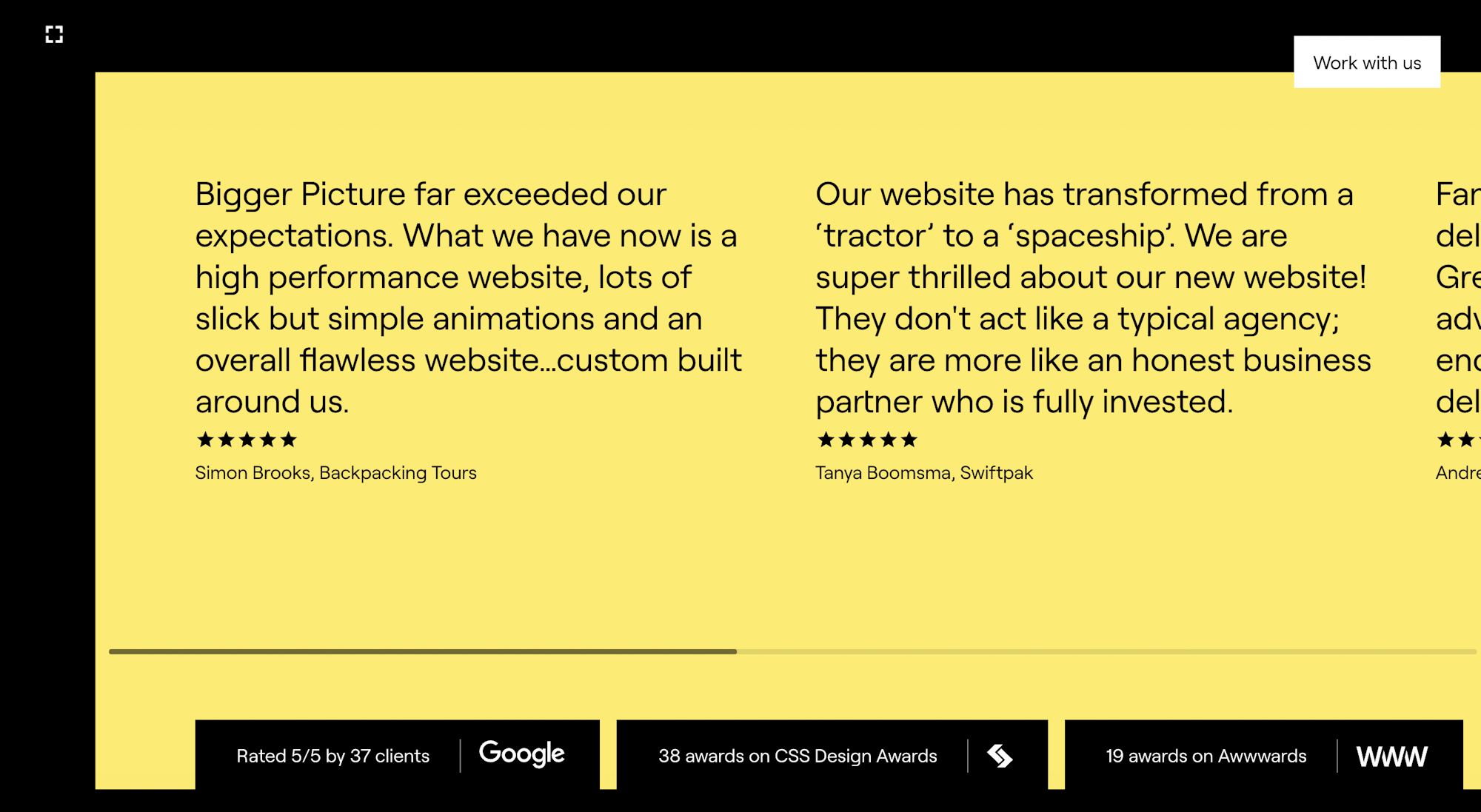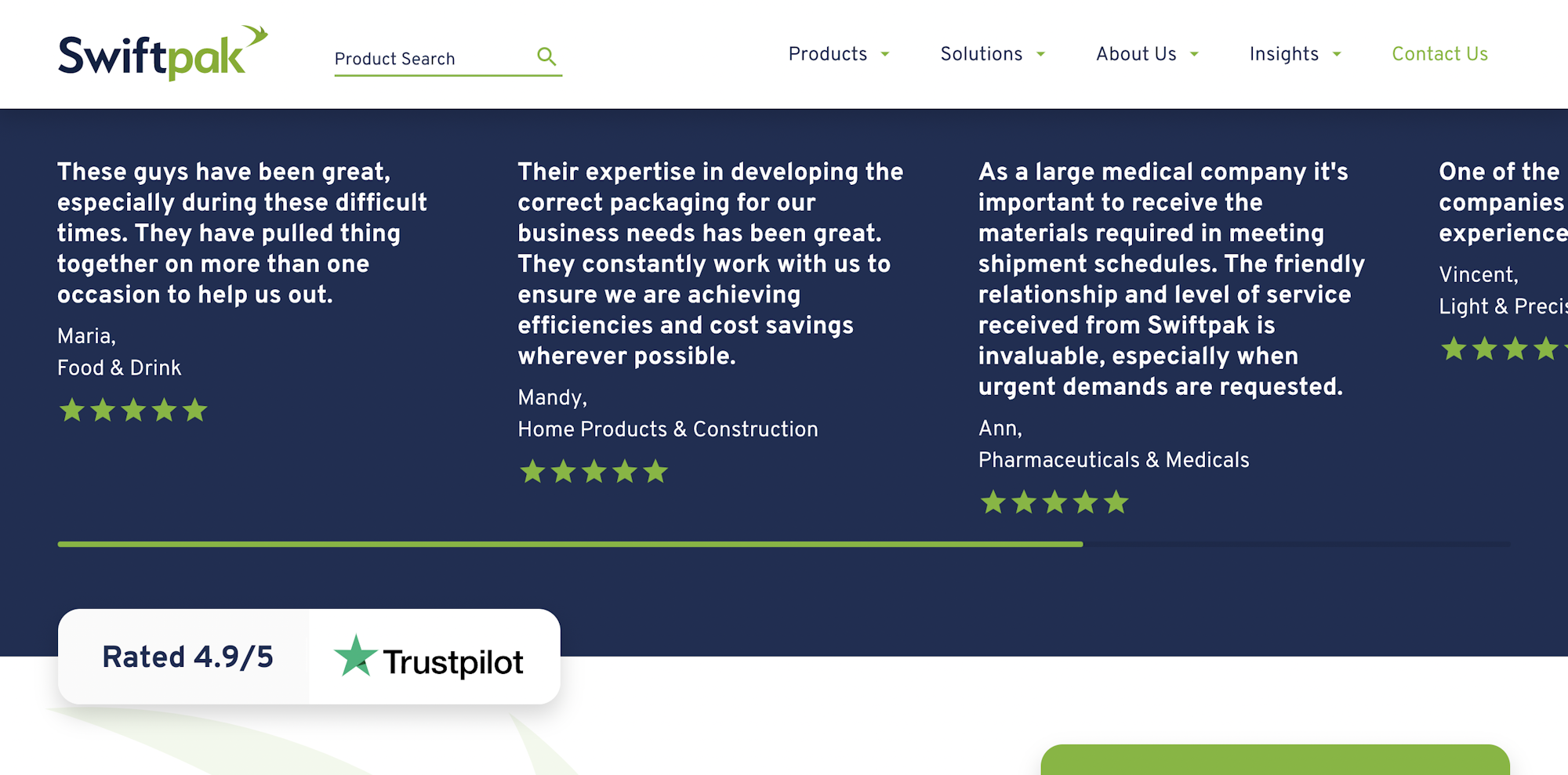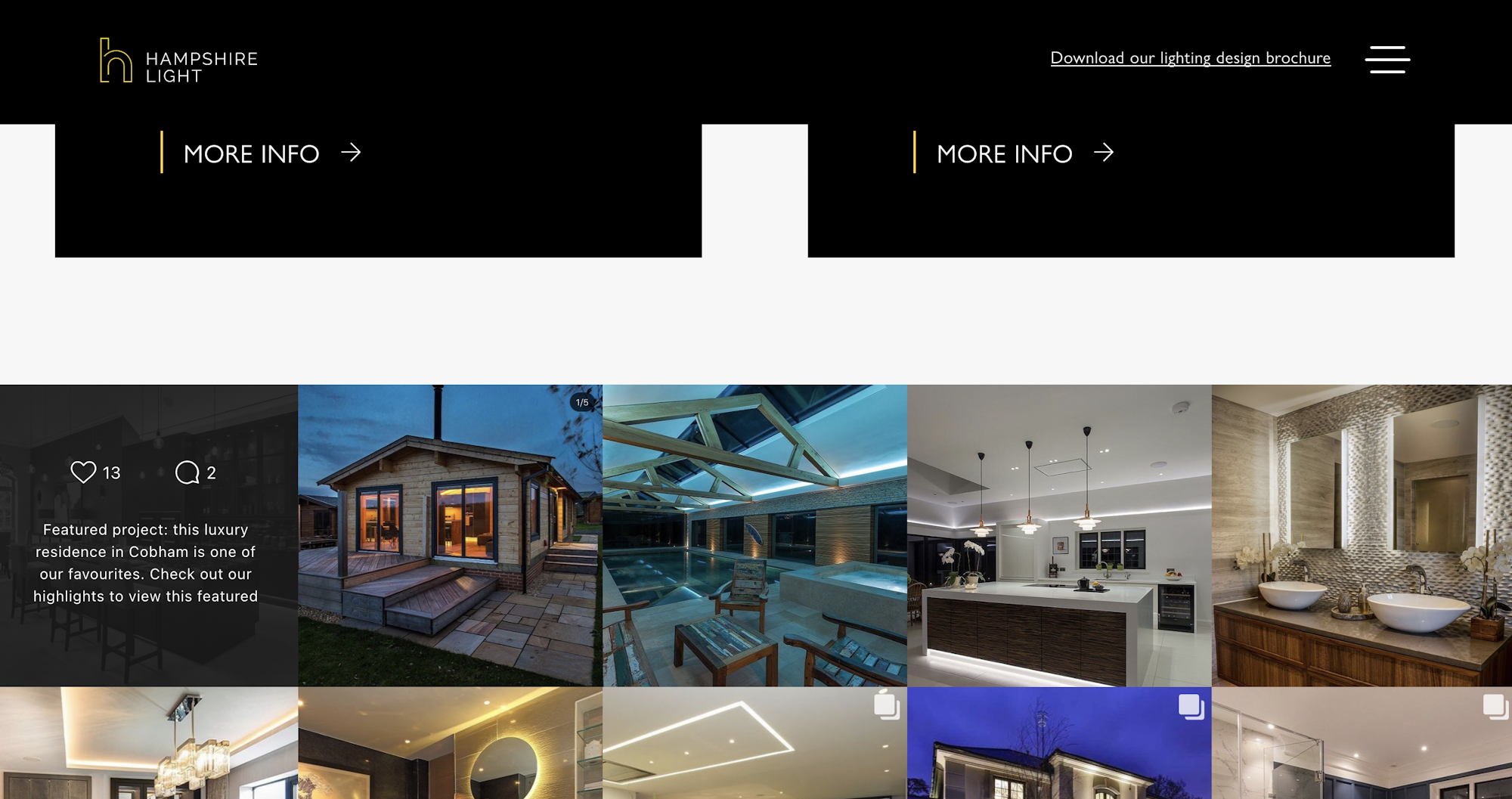Why does trust matter when it comes to web design? Well, people buy from brands and websites that they trust.
If your website encourages the slightest inkling of uncertainty, then you’ve already lost the sale.
But building a trustworthy brand and website doesn’t need to take years. There are some quick changes you can make to your web design that will boost the trust-building process.
We’ve listed 9 ways that you can build brand trust with web design.
1. Layout and web design
It's surprising how many how many websites will fail to consider the impact that layout and web design has on trust.
Your website is the perfect chance to give the best first impression of your brand.
Think about it this way. A user has come across a really cool display ad for one of your products, clicks on it and then lands on a website that is outdated and badly designed. They are going to leave straight away.
Firstly, your web design isn't consistent with your marketing efforts, which has already reduced your chances of building trust.
If by some miracle, the user does decided to stick around, it's likely that their user experience will be pretty poor.
If your design is clunky and old, and navigation is a real challenge, you aren't making a great start in building that all-important customer trust.
TIP: If you're planning on keeping Google happy too, your site needs to be fast loading and responsive on both desktop and mobile.
A well-designed site should be easy to use and designed with user experience in mind. Designing a great website is the first step to building a trustworthy brand.
2. Credibility indicators
If the plan is to attract new customers, it's likely they're not going to know anything about your brand.
Once they land on your site, they'll be scanning for signs that you are operating as a credible business.
Try adding some of the following indicators to make your customers feel more comfortable:
Testimonials
Did you know 91% of people trust reviews and testimonials as much as personal recommendations?
Potential customers are always looking for extra information. So if your customers are praising your business on product quality, customer service or fast delivery times, don't be afraid to shout about it!
Ensure testimonials are part of your web design and include your best reviews on your website.
Make the most of your good reputation by posting reviews on your social channels too - in moderation, of course. Nobody likes a bragger!
If possible, try and include video testimonials as well. This will only increase your chances of building trust. We recently wrote about why you should incorporate video in your web design strategy.

Links to review sites
Testimonials are great for building trust, but external review sites can be even better.
Whilst people will still trust testimonial reviews, they know that brands are only going to post positive testimonials on their site.
People that post on external review sites, like Trustpilot, will often do it off their own back, which can make the reviews seem more authentic and less biased.
Including links to external reviews on Google and Trustpilot will show visitors that you have nothing to hide! Make sure to include this section into your web design.
Swiftpak show a great example of this on their website, where they have combined their testimonials and external reviews section together.

Client logos
This is the perfect opportunity to show off some of the bigger, well-known brands you work with (if they will allow you to, that is!)
Your visitors want to see who you have previously worked with. If other brands trust you, then why shouldn’t they?
If you have provided a product or service to a client, double check with the company before you add their brand logo to your site.
Social proof
This is chance to prove that people follow and engage with your brand. If you don’t have much engagement or social following, now is the time to start. Choose a platform that you think will work best for your business.
If your product or service is lead by imagery, consider starting on Instagram. If your brand would benefit from humorous video content, try out TikTok.
Use this opportunity to encourage the visitor to visit your brand on other platforms. “Check us out Instagram” or “join 25,000 other readers and subscribe to our newsletters” are great trust-building CTAs to push the customer onto your social channels. Include an live Instagram feed in the footer of your website, like Hampshire Light have done in the example below.

Awards and industry recognition
You’ve worked hard to attain recognition, so it’s only right that you’d want any achievement you've gathered along the years to be showcased.
However, you don’t want to seem like you’re just showing off. So, figuring out where and how to show off your awards and industry recognition can be tricky.
When awards are added in a tasteful way, they can add authenticity to your site and increase trust.
Emphasise your achievements subtly by adding an animated graphic or placing awards in the footer.
Show your visitors why people trust you. Once they know you're a credible business, they are more likely to become customers.
3. Trust markers
With so many people falling victim to scams online, it can be even more difficult to build brand trust.
Thankfully, there are some very easy ways to let visitors know that your site is safe and secure to use.
SSL certificate
This is a basic requirement of any website, but many sites don't have them or forget to renew them when they run out.
If your website does not have an SSL certificate, you will probably take a hit on your Google search rankings, and lose some trust from more tech-savvy visitors that understand the difference between a secure and non-secure site.
Accessible privacy policy
The purpose of your privacy policy is to let your users know how their data is being used. Therefore, your privacy policy needs to be accessible for your users so they can access this information.
Your privacy policy should be clear and easy to understand.
Reassure your visitors that you will keep their information safe and that your business is trustworthy.
Error-free and well written content
Written content is usually the first thing that visitors see when they’re considering working with your business.
If your content includes lots of misspelled words, bad grammar or sentences that don’t make sense, customers may reconsider whether they really want to work with your company.
One mistake can distract your reader and weaken the message of your content, putting your chance of a sale at risk and affecting the credibility of your business.
4. About Us page
Unless your brand is a household name, it’s a good idea to include an About Us page on your site. Visitors usually want to find out more about your brand before handing over personal information like email addresses, phone numbers, or even payment details.
Your About page is also the perfect place to showcase your brand personality, and demonstrate your value to potential clients. Many businesses use their About page to tell stories about the business to try and create a connection with the reader.
Try to avoid using your About page to list off your accomplishments. Instead, keep your copy focused on your clients and how you can help them.
The About Us page is one of the most visited pages on a website, so don’t let this opportunity to build trust go to waste.
5. Contact page
Nothing screams red flag like a lack of contact information.
Visitors can easily find the address and phone number of a local business with a simple Google search these days, so people are rightly suspicious of websites that don’t disclose their contact information.
Similar to your About page, this is your chance to interact with customers. Make chat boxes, email addresses and phone numbers readily available to your customers.
Your contact page is one of the most important pages on your website. There’s no logical reason to make it hard for potential customers to contact you.
Help out your visitors by providing contact information in sensible places, like in the footer, and strategically place contact call-to-actions around your website.
Celebration of Life's contact page includes great examples of subtle contact CTAs placed around the page. Note all the different options available to the user; the Call Us button in the navigation menu, as well as an email address, phone number, postal address and contact form.

6. Web design consistency
Consistency in web design is vital when it comes to building brand trust. It applies to everything from design, colour, fonts, and tone of voice.
Consistency across these elements will provide a better user experience, ensure that your website looks coherent, and will prevent the user from getting distracted.
Create web design consistency by following these easy steps:
- Have menus in the same position on each page
- Use the same fonts and colours throughout the site
- Have a clear hierarchy to the elements on your site
- Ensure that your logo consistently appears on each page (and links back to the homepage)
7. Helpful, relevant content
Google has always praised “high quality content” as a ranking factor. But how do you know if your content is high quality?
If your content is helpful, that’s a great place to start. To earn trust, you have to be willing to help your visitors (even if they’re not working with your business yet).
Providing helpful, relevant content is also a great chance for your business to be a thought leader in your industry.
Still keep Google in mind when creating content, but write for real readers. By offering helpful, valuable content, you’re already on the way to building brand trust.
Create content that Google loves and your customers can actually use.
8. Use authentic imagery
Imagery is undoubtedly one of the most important elements when it comes to successful web design, and can often be what makes a website stand out from its competitors.
When it comes to choosing the photos you put on your website, there are two main choices: stock imagery, or authentic photographs.
Whilst stock photos can be of some benefit, the most effective websites are those that are rich in unique, high-quality photos.
Incorporating images of your team, or professionally taken pictures of your product or service are one of the best ways you can immediately build credibility.
If you are unsure of how to incorporate authentic imagery into your web design, consider the following pointers:
About page
Take both group and individual photos of your team to help establish a personal connection. Visitors will feel more confident speaking to someone new if they have some kind of understanding of what they’re like in advance.
Location photos
If your office space is going to impress, make sure you show it off. Use these photos on your website, but post on social media so customers can gain some understanding of your company culture too.
Product images
High quality product images are always valuable, and not just for your website.
Take photos of your products that can work on your product pages, social campaigns and homepages.
Images in a studio setting might be better suited for marketing and sales, whereas homepage imagery can include customers interacting with your brand products.
Branding
You’re probably going to want your brand colours in the imagery on your website, and original photography gives you the power to do this.
By arranging your own photoshoot, you can ensure your logo and brand colours are in the shots you need them in.
9. Be transparent with your communication
If you’re looking to inspire loyalty and trust, you’ll need to be transparent with your customers.
Customers want in-depth information without a spin. They don’t like vague language or hidden messages that require them to read between the lines.
Transparent communication is an essential part of successfully building brand trust. So, how can you write transparently?
Example: Share information about your products. What are they made of? Where are they made? Are they recyclable?
Even if your packaging isn’t recyclable, be honest. Visitors trust brands that are honest, and they will trust you more if they can easily find this information on your site.
How to build brand trust with web design
In 2021, customers have increasingly more options when it comes to choosing a brand to work with. In such a competitive environment, brand trust has become more important than ever.
At Bigger Picture, we really do believe in the importance of delivering better customer experiences, and getting to know your customers’ wants and needs.
If you’re looking for web design agency in Hampshire to help your brand become more reputable online, we can help. Get in touch with our team today - we’d love to have a chat.

